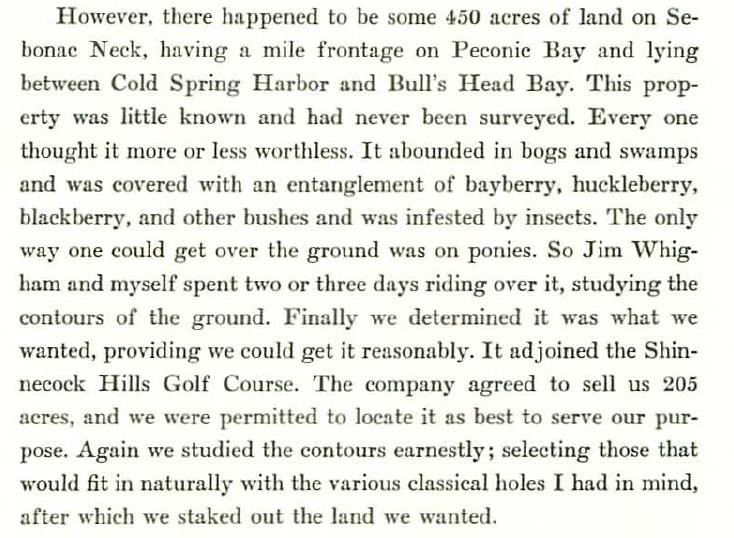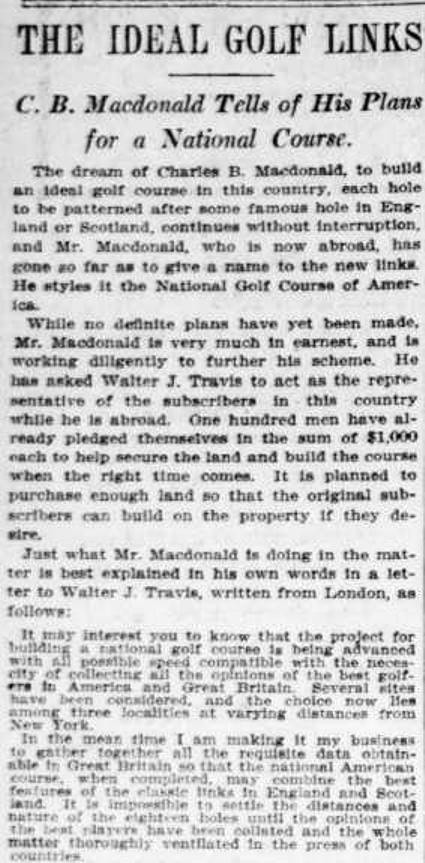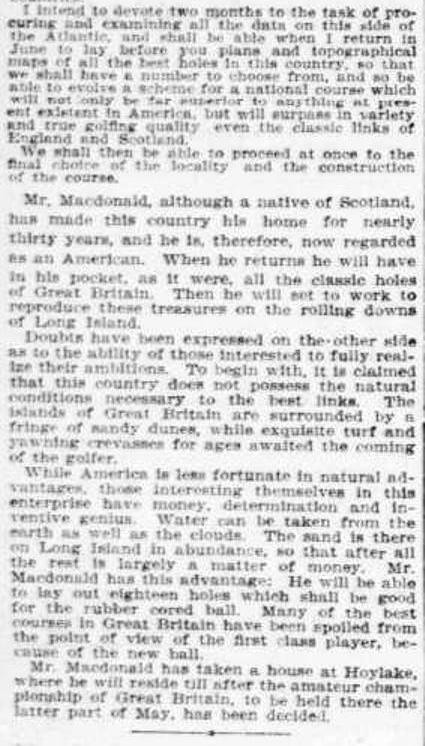There is neither a "problem" nor a "glaring error" with my summary of CBM's chronology of events from Scotland's Gift. And he was writing a narrative which included a chronology of events.
In contrast, your chronology flip-flops events in an way that CBM obviously did not intend, and in a way which directly contradicts the December news accounts. For example, read this excerpt from CBM:
. . . So Jim Whigham and myself spent two or three days riding over it, studying the contours of the ground. Finally we determined what it was we wanted, providing we could get it reasonably. It joined Shinnecock Hills Golf Course. The company agreed to sell us 205 acres, and we were permitted to locate it as to best serve our purpose. Again, we studied the contours earnestly; selecting those that would fit in naturally with the various classical holes I had in mind, after which we staked out the land we wanted.
We found an Alps; found an ideal Redan; then we discovered a place we could put the Eden hole which would not permit a topped ball to run-up on the green. Then we found a wonderful water-hole, now the Cape.
Let me ask you . . . By CBM's account, which event happened first:
"The company agreed to sell us 205 acres, and we were permitted to locate it as to best serve our purpose."
OR
"Again, we studied the contours earnestly; selecting those that would fit in naturally with the various classical holes I had in mind, after which we staked out the land we wanted.
We found an Alps; found an ideal Redan; then we discovered a place we could put the Eden hole which would not permit a topped ball to run-up on the green. Then we found a wonderful water-hole, now the Cape. . . ."
The answer is obvious, and it doesn't match your chronology.
___________________________________________________________
As for your claim that I made a "glaring error" about the date they first staked out the land they wanted, I disagree. By mid-December CBM had already chosen roughly 205 acres from among the 450 acres, and he provided a detailed physical description of the that parcel he intended to purchase. That would have been pretty hard to do had he not staked it out first.
CBM did say that the "exact lines" would not be staked out until the plans were complete, but so what? Do you really think the developer is going to sell an option without the land having been at least roughly marked off to show both parties the subject of the transaction?
David,
If I might, I prefer to answer your last question first and I think the answer is “Yes”, I do think the developer provided Macdonald with an “option” for 200 of the roughly 450 acres available on Sebonac Neck
without the land being staked off.Remember that CBM told us that,
“the land had never been surveyed and every one thought it was more or less worthless”. We know that land wasn’t in the developer’s real estate plan that spanned thousands of acres that had been surveyed by Olmstead and Vaux. We also know that the first 120 acre site
“near the (Shinneock)
canal” that Macdonald wanted and the developer rejected was right smack dab in those development plans that were created in 1906.
Macdonald also told us that Sebonac Neck was so overgrown and bug-infested that it could only be traversed by horseback. I have to ask exactly how that staking would take place on such a property, because almost assuredly it hadn’t been cleared prior…who would have provided funding for such an effort that we also know from other sources didn’t take place until 1907.
So I would envision that if we were to find the written terms of that agreement it would likely refer to the 200 acres in general terms, from the Shinnecock Hills Golf Course along the natural eastern boundary of the property out to the Peconic Bay. Perhaps something like this;
“We have a stretch at our disposal of four acres in width and two miles long. The exact lines will not be staked out until the committee has finished its plans, for latitude has been given to us in this respect as all concerned want the course to be ideal. Bullshead Bay will be skirted for about a mile…”Now I think we previously decided that Macdonald meant that an acre wide was 208.71 feet (time 4 acres for roughly 835 feet or 278 yards) and if we take that and multiply it by the 10,560 feet of two miles we get just slightly over 200 acres in total. Now, both are slightly off in the sense that the course wasn’t quite as long as 2 miles, even if we travel as the golfer does and not as the crow flies, and we know the width eventually varied widely across the property from over 450 yards wide in spots to areas under 200 yards. But still, CBM was describing what I would best describe as a “container”, a land parcel that included all of the natural features he and Whigham found on horseback and certainly more than enough land to build a golf course by his previous estimates.
So viewed in this light, it puts the timeline you describe in a completely different context.

Macdonald tells us the property was little known and had never been surveyed. He also tells us it was remote, it was overgrown, it was bug-infested, and yes, everyone thought it essentially worthless (presumably for farming or real estate). He describes riding on horseback and determined that they wanted it IF they could get it for a decent price. Remember, they had previously been rebuffed on their first attempt to buy land from this developer although the developer saw value in their National golf course being located nearby, no question.
Before I go on, perhaps it is now the best time to go back in time a few months to the spring of that same year, 1906. CBM and Walter Travis have been communicating back and forth via letter as Macdonald is in Europe getting drawings of the famous holes, over 30 of them.


It’s clear from this report from March 24th, 1906 that the real estate component is still in Macdonald’s plans for his new club. But how could this be? Didn’t CBM say that he made his original offer to the developer a few weeks after the real estate company purchased the land?? Actually, no he didn’t and that’s another misunderstanding we have. What he wrote was,
“The Shinnecock Hills property, some 2000 acres, had been owned by a London syndicate and was sold at about $50 an acre to a Brooklyn company a few weeks before I determined that we should build a course there if we could secure the land.”This was in late 1905, but what was the next thing this eager buyer did? He planned a several months long trip abroad to study golf holes and get/make drawings of them in the spring of 1906!
The March report tells us that three Long Island sites were under consideration. I think we can safely assume that the Canal site was one of them. Other reports had him looking near Montauk. Do I think CBM had already made an offer at that time for the Canal site. No, I don’t think there’s any evidence of that at all; instead what CBM said is that a few weeks after the purchase he determined to build a course in the Shinnecock Hills if he could secure the land.
Which leads me to the question; why would Macdonald even mention a failed attempt to purchase land in his book over 20 years after the fact? I think the reason is that it was directly related to him finding the Sebonac Neck site in the first place. It’s not tough to envision a scenario where CBM makes an offer to buy the 120 acres of land near the Canal, the owner tell him that’s primo real estate, but suggests some remote, overgrown land under their control that isn’t planned to be developed for housing out on Sebonac Neck. With that, Macdonald and Whigham go for their rides, find the landforms and soils they were hoping for, and in November of 1906 they secure the right to purchase whatever 200 acres up there eventually suits their fancy for the golf course.
Macdonald signs the papers on December 14th 1906 and it’s reported in the press that weekend. All the NYC news reports mention the real estate component for the Founders and neither the Real Estate company nor Macdonald blanch at that plan, much less rebut it.
The reports announce Macdonald’s plans to use the next five months to select which holes to use, determine the yardages, plan the holes in detail, after which they will stake out the final routing and course boundaries and complete the purchase. That work is completed as planned and in May of 1907 Mortimer S. Payne is hired to supervise the imminent construction.
It’s interesting that you recently noted that you don’t think CBM routed from a topographic survey and I don’t think so either. In fact, I think he hired Raynor that spring to first survey the boundaries as they were determined and then to create a topographical map to compare to his overseas drawings and therefore guide construction. Here’s how CBM referred to Raynor’s work there;
”Employing him to survey our Sebonac Neck property I was so much impressed with his dependability and seriousness I had him make a contour map and later gave him my surveyor’s maps which I had brought from Scotland and England, telling him that I wanted those holes laid out faithfully to those maps.” Notice the "our" suggesting it was already purchased or at least secured by then.
After securing the land in December of 1906 (i.e.
“The company agreed to sell us 205 acres and we were permitted to locate it as best to serve our purpose”, almost exactly what Macdonald is quoted in December 15th news reports), CBM wrote;
“Again, (as in, for the second time)
we studied the contours earnestly; selecting those that would fit in naturally with the various classical holes we had in mind, after which we staked out the land we wanted.” In his next paragraph, Macdonald tells us more about the property they found and some of the natural landforms to accommodate his redan, an Alps, a place with a water carry for his version of an Eden. And yes, these were all found prior to December 1906 during his rides around the property with Whigham (interesting that he doesn’t name Travis who later claimed to be part of that activity, but that’s a discussion for another day.)
Then, almost as an after-thought, or perhaps remembering the differences between the accessibility, planned surrounds, and purpose of the two different sites, he writes;
”The property was more or less remote, three miles from Southampton, where thoroughfares and railroads would never bother us – a much desired situation. When playing golf you want to be alone with Nature.”In the next paragraph CBM tells us more about the timing of events;
"We obtained an option on the property in November 1906 and took title to the property in the spring of 1907. Immediately we commenced development.”So, I hope you’ll understand that our respective interpretations of what CBM wrote are different and as such, the two questions you asked above are not relevant based on my interpretation which I’ve just described. I don’t think Macdonald’s description of events followed in complete chronological order and his written thoughts bounced around a bit. Also, let’s please avoid subsequent discussion on the October news reports about him sending survey maps to those overseas because I think I can show pretty easily that those reports didn’t understand what was being shared back and forth, a discussion on which holes were in fact Ideal, as well as CBM receiving topos and related drawings from his friends of some of those famous holes.
Finally, I know you asked some additional questions related to the value of the property which I’d simply answer this way. The developer clearly thought having Macdonald’s National golf course near his development would be a boon to his real estate which is why he went to the additional expense of building the Shinnecock Inn and providing CBM “latitude” over several months to determine the final boundaries of his purchase. However, somewhat ironically, it never worked, very little was ever sold and perhaps the entire failed financial fate of the Real Estate company was writ when they rejected CBM’s initial offer near the Shinnecock Canal. For however adjacent or proximate the development came to Sebonac Neck, it evidently wasn’t close enough for the vast majority of club members to ever purchase lots.
I hope that helps explain my position. Thanks.